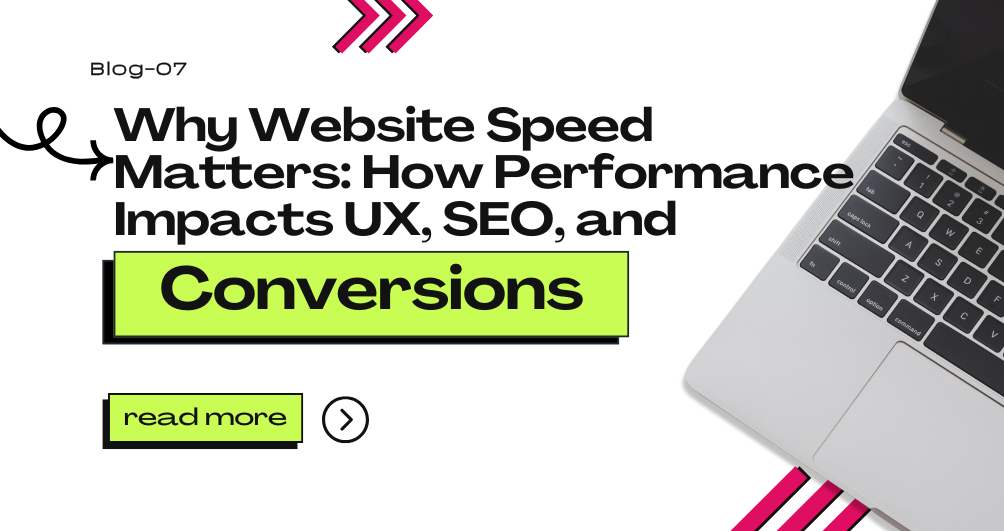Introduction
In today’s fast-paced digital world, website speed is more than just a luxury—it’s a necessity. Users expect fast-loading websites, and when they don’t get them, they leave. Not only does a slow website frustrate visitors, but it also impacts your search engine ranking, which can hurt your online visibility and conversions.
Whether you’re running a personal blog, an e-commerce site, or a business website, ensuring your pages load quickly is crucial. In this article, we’ll dive into the importance of website speed, how it impacts user experience (UX), SEO, and conversions, and what you can do to optimize your site for faster performance.
What Is Website Speed?
Website speed refers to how quickly the content on your website loads. While many metrics can measure speed, the most common are:
- Time to First Byte (TTFB): The amount of time it takes for a user’s browser to receive the first byte of data from the server after requesting a page.
- First Contentful Paint (FCP): The time it takes for the browser to render the first visible piece of content (text, image, etc.).
- Largest Contentful Paint (LCP): Measures the time it takes for the largest visible content element (such as an image or block of text) to load.
- Time to Interactive (TTI): The amount of time it takes for the page to become fully interactive and usable.
These metrics give an overview of how well a website is performing and how quickly a user can begin interacting with it.
Why Website Speed Matters for User Experience (UX)
User experience is one of the most important factors for any website. A positive UX leads to higher engagement, more time spent on the site, and higher conversion rates. Here’s how website speed plays a critical role:

- First Impressions Matter: Visitors form opinions about a website within seconds. A slow website gives a poor first impression and can lead to higher bounce rates. In contrast, a fast-loading website makes a positive first impression and encourages users to stay longer.
- Faster Load Times = Lower Bounce Rates: A slow website leads to frustration and impatience. If a page takes too long to load, users are more likely to leave before interacting with any content. According to Google, 53% of mobile users abandon a page if it takes longer than 3 seconds to load.
- Improved Navigation: Users expect seamless navigation. If your site is sluggish, it can disrupt the user’s flow, leading to frustration. A fast website ensures that users can smoothly interact with your content, navigate through pages, and complete tasks without delays.
- Mobile Optimization: More users access websites through mobile devices, which often have slower internet connections than desktops. If your site isn’t optimized for mobile speed, you’ll lose out on a large segment of your audience. Google has already implemented mobile-first indexing, which means it evaluates the mobile version of a website first for ranking purposes.
Website Speed’s Impact on SEO
Google has made it clear that page speed is a ranking factor. With Core Web Vitals becoming an essential part of ranking, website speed directly influences your site’s position on the search engine results page (SERP). Here’s how website speed impacts SEO:
- Faster Crawling and Indexing: Search engines like Google crawl websites to gather information about them and determine where they should rank. Faster websites allow crawlers to scan more pages in less time, which can help index your content more efficiently.
- Core Web Vitals and Ranking: As part of its Page Experience Update, Google introduced Core Web Vitals as ranking factors. These include Largest Contentful Paint (LCP), First Input Delay (FID), and Cumulative Layout Shift (CLS). All these metrics are directly related to how fast and responsive your website is, making speed a crucial factor in ranking.
- User Engagement and Bounce Rates: Google takes user engagement into account when determining rankings. A fast website leads to better engagement and lower bounce rates. Websites that have lower bounce rates and higher session durations tend to rank better on Google. On the other hand, slow websites often see higher bounce rates and shorter sessions, which can hurt your rankings.
- Mobile-First Indexing: With mobile usage on the rise, Google now uses the mobile version of your website to determine rankings. If your mobile version is slow to load, it could significantly impact your rankings. Google’s mobile-first indexing emphasizes the importance of ensuring that your mobile site is both fast and optimized.
How Speed Affects Conversions
One of the most overlooked aspects of website speed is its direct impact on conversion rates. Whether you’re running an e-commerce store, collecting leads, or promoting a service, slow websites lead to lost revenue. Here’s how speed impacts conversions:
- First Impressions: Just like with UX, the first impression a user gets from your website influences whether or not they’ll convert. A fast-loading website feels professional and reliable, which can increase trust and lead to more conversions.
- Shopping Cart Abandonment: In the eCommerce world, slow checkout pages can lead to cart abandonment. According to a study by Baymard Institute, slow page load times contribute to 18% of shopping cart abandonment. If users can’t quickly check out, they’re likely to abandon their purchase.
- Lead Generation: For businesses that rely on lead generation, slow landing pages can result in fewer form submissions. The longer it takes for a page to load, the less likely users are to stay on the page to complete a form.
- Customer Retention: Fast websites not only attract more visitors, but they also encourage repeat visits. A website that loads quickly creates a positive experience, leading to greater customer satisfaction and higher lifetime value.
Factors That Can Slow Down Your Website
Several factors contribute to slow website performance. Understanding these elements can help you optimize your website for faster loading times.
- Unoptimized Images: Large image files, particularly those not compressed or resized, are one of the biggest culprits behind slow websites. Images should be optimized for the web using tools like TinyPNG, JPEG-Optimizer, or ImageOptim.
- Excessive HTTP Requests: Every element on your website—images, stylesheets, scripts, and fonts—requires an HTTP request. Too many requests can slow down the loading time. Minimize HTTP requests by combining files, using CSS sprites, and reducing the number of elements on your page.
- Heavy JavaScript and CSS Files: Large and unminified JavaScript and CSS files can increase load times. Use tools like UglifyJS or CSSNano to minify your files, which reduces their size and improves performance.
- Too Many Plugins: While plugins can enhance the functionality of your website, having too many can significantly slow down your site. Choose only essential plugins and ensure they are regularly updated.
- Poor Web Hosting: The quality of your hosting provider plays a significant role in website speed. Shared hosting, in particular, can be slow, as multiple websites share the same server resources. Opt for a dedicated server or managed WordPress hosting if performance is a priority.
- Lack of Caching: Caching stores static versions of your website’s pages to serve them to users more quickly. Without caching, each time a user visits your site, the server has to generate a fresh page. Enable browser caching and use a Content Delivery Network (CDN) to reduce load times.
How to Improve Your Website Speed: Actionable Tips
Here are practical steps you can take to optimize your website for speed:
- Choose a Reliable Hosting Provider: Invest in high-quality hosting that offers solid uptime, fast servers, and customer support.
- Leverage Browser Caching: Set expiration dates for resources like images, CSS, and JavaScript files to improve subsequent page loads for returning visitors.
- Use a Content Delivery Network (CDN): A CDN distributes your website’s content across multiple servers worldwide, ensuring faster load times for users, regardless of their location.
- Minify CSS, JavaScript, and HTML Files: Remove unnecessary spaces, comments, and code from your files to reduce their size.
- Optimize Your Images: Use the correct file formats (JPEG for photos, PNG for graphics with transparency) and reduce their size without compromising quality.
- Enable GZIP Compression: GZIP compresses text-based files like HTML, CSS, and JavaScript, making them smaller and faster to load.
- Limit the Use of External Embedded Media: While embedded media like videos and social media feeds can enrich your content, they can slow down load times. Use them sparingly and ensure they are optimized.
- Optimize Your Database: Over time, your database can accumulate unnecessary data. Regularly clean up and optimize your WordPress database to keep it running smoothly.
Tools to Test and Monitor Website Speed
To keep track of your website’s speed, use these tools:
- Google PageSpeed Insights: Provides insights into how your site is performing and gives specific recommendations for improving speed.
- GTmetrix: Offers a detailed breakdown of your website’s performance and insights into what’s slowing it down.
- Pingdom: An easy-to-use tool for testing website performance and uptime monitoring.
- WebPageTest: Provides in-depth performance analysis with visual snapshots of how your site loads.
Conclusion
Website speed plays a critical role in user experience, SEO, and conversions. A fast website keeps users engaged, improves your search rankings, and increases your conversion rates. In today’s digital world, where competition is fierce and attention spans are short, website speed can make the difference between success and failure.
By following the actionable tips outlined above, you can optimize your website to provide a better experience for your users, rank higher on search engines, and ultimately boost your conversions. Speed isn’t just a technical improvement—it’s a competitive advantage. Don’t wait until your slow website costs you traffic and revenue—start optimizing today!
Ready to Boost Your Website’s Speed?
Don’t let slow loading times hold your business back. Improving your website’s performance can elevate your user experience, enhance your SEO rankings, and increase conversions. If you’re ready to optimize your website speed, contact our expert team today to get started with a free website audit.
Get in touch now and take your website’s performance to the next level!


